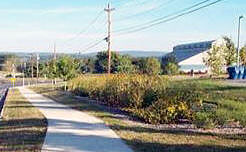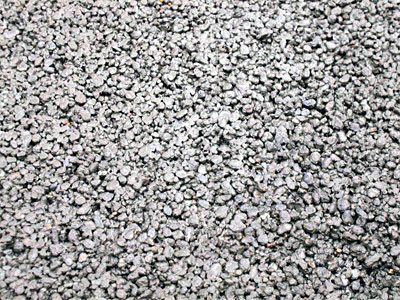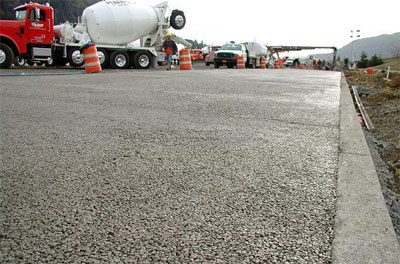Pervious Concrete
Why Use It?
pervious concrete | why use it? | properties | installation | testing | success stories | faqs
Environmental Benefits
Stormwater Management
The permeability of porous concrete provides a potential solution to the problem of stormwater runoff, which is a serious environmental concern accompanying increased urbanization. When land is covered with impervious parking areas, driveways, and transit areas, rainfall is unable to soak into the ground as it would under natural conditions. It must therefore flow off the pavement and into adjacent areas, which can result in flooding, erosion, and disruption of the environmental balance.
 The situation is made worse by the runoff of toxic automobile pollutants such as oil and antifreeze, which accumulate on the pavement surface and are then carried away by rainfall. According to the U.S. Environmental Protection Agency, stormwater runoff can send as much as 90% of parking area surface pollutants directly into our rivers and streams. The EPA now requires state and local governments to implement measures to reduce and improve the overall quality of stormwater runoff in an effort to address this important issue.
The situation is made worse by the runoff of toxic automobile pollutants such as oil and antifreeze, which accumulate on the pavement surface and are then carried away by rainfall. According to the U.S. Environmental Protection Agency, stormwater runoff can send as much as 90% of parking area surface pollutants directly into our rivers and streams. The EPA now requires state and local governments to implement measures to reduce and improve the overall quality of stormwater runoff in an effort to address this important issue.
In order to fulfill EPA stormwater regulations, runoff from impervious parking areas has traditionally been controlled with the use of containment methods such as retention ponds and swales. Though functional in their reduction of erosion and flooding, these solutions are costly to implement, requiring the purchase of additional land space. Furthermore, by serving as collection troughs for toxic pollutants as well as rainwater, they are detrimental to the environment despite their effective runoff containment.
Pervious concrete parking areas eliminate the need for retention ponds and other runoff collection methods, providing for more efficient land use. This benefits not only the building owner economically, but the entire community environmentally and aesthetically. Rather than directing and storing stormwater off-site, the pavement's open-cell structure models natural ground cover, allowing rainwater to filter through to the underlying soil. This leads to an equivalent aquifer recharge and groundwater increase as would occur in a grass-covered area. Furthermore, the air voids of pervious concrete provide a medium for aerobic bacteria which naturally break down many of the pollutants that seep from parked cars.
High Albedo, Low Lighting Costs
 Concrete surfaces have a much higher albedo (measure of reflectance) than competitive paving materials. Specifications requiring a minimum surface albedo are becoming increasingly common. The inherently light color of concrete naturally reflects heat and light. Studies have shown that concrete's reflectivity can lower lighting costs by as much as 30% over other pavements.
Concrete surfaces have a much higher albedo (measure of reflectance) than competitive paving materials. Specifications requiring a minimum surface albedo are becoming increasingly common. The inherently light color of concrete naturally reflects heat and light. Studies have shown that concrete's reflectivity can lower lighting costs by as much as 30% over other pavements.
Parking Area Ecosystems
Like conventional concrete, pervious consists mostly of Portland cement, water, and aggregates. Its unique porous quality is achieved by eliminating fine aggregates, such as sand, from the mix. The exclusive use of course aggregates such as gravel and crushed stone creates air voids throughout the concrete. Water is therefore able to pass directly through the pavement and into the soil rather than collecting on or running off the surface. In this way, pervious concrete can greatly reduce stormwater runoff and its associated problems.
 Automobile pollutants are absorbed into the concrete along with rainwater, which allows the soil chemistry and biological processes to “treat” the toxins naturally and effectively. With impervious pavements, these chemicals collect on the surface and are then swept into the surrounding environment and water systems when it rains. This major cause of pollution can be prevented by simply using pervious concrete.
Automobile pollutants are absorbed into the concrete along with rainwater, which allows the soil chemistry and biological processes to “treat” the toxins naturally and effectively. With impervious pavements, these chemicals collect on the surface and are then swept into the surrounding environment and water systems when it rains. This major cause of pollution can be prevented by simply using pervious concrete.
Also, with rain unable to percolate into the soil beneath impervious pavements, plant roots are deprived of water and oxygen. This leads to the stunted growth and shortened lifespan of parking lot trees, a significant problem since trees are necessary for shading and air quality maintenance, as well as aesthetics. Such problems can be avoided with the use of pervious concrete, since its void structure mimics that of grass, allowing equivalent amounts of water and oxygen to reach tree roots.
Furthermore, the infiltration and sub-pavement collection of rainwater leads to aquifer recharge and increased groundwater, providing healthy conditions for tree growth. This means that in pervious parking lots, paved space can be maximized without sacrificing the benefits provided by trees. Pervious concrete functions like a stormwater retention basin and allows the stormwater to infiltrate the soil over a large area, thus facilitating recharge of precious groundwater supplies locally.
Heat Island Effect
The heat island effect is a phenomenon which has accompanied and increased with urbanization, and it refers to the fact that man-made structures tend to attract and retain heat at a higher rate than is normal in nature. This results in an increase in ground-level ozone production by as much as 30%. In 2005, a tightly-packed urban area can average as much as twelve degrees warmer than its surrounding rural regions.
 Choice of building material is key in reversing the heat island effect, for it is the dense, dark-colored structures which attract sunlight and retain it for long periods of time. All concrete, including pervious concrete, has a light color that resists heat absorption. The open pore structure of pervious concrete allows air to circulate within, resulting in even lower heat retainment.
Choice of building material is key in reversing the heat island effect, for it is the dense, dark-colored structures which attract sunlight and retain it for long periods of time. All concrete, including pervious concrete, has a light color that resists heat absorption. The open pore structure of pervious concrete allows air to circulate within, resulting in even lower heat retainment.
Furthermore, since trees are able to coexist with porous pavement, they can easily be incorporated into urban settings. Trees provide shade and release oxygen, both which contribute significantly to the lowering of temperatures. By incorporating these strategies and reducing the heat island effect, air conditioning costs can be lowered by as much as 12%, the intensity of air pollution lessened, and heat-related health problems prevented.
Economic Benefits
Alternative to Costly Stormwater Management Methods
 Parking areas paved with pervious concrete reduce the need for large detention ponds, because the pavement itself acts as a detention area. Parking lot owners that use pervious will spend fewer dollars on the labor, construction, and maintenance of detention ponds, skimmers, pumps, drainage pipes, and other stormwater management systems.
Parking areas paved with pervious concrete reduce the need for large detention ponds, because the pavement itself acts as a detention area. Parking lot owners that use pervious will spend fewer dollars on the labor, construction, and maintenance of detention ponds, skimmers, pumps, drainage pipes, and other stormwater management systems.
Expensive irrigation systems can also be downsized or eliminated. In reducing runoff from paved areas, pervious concrete reduces the need for separate stormwater retention ponds and allows the use of smaller-capacity storm sewers. This allows property owners to develop a larger area of available property at a lower cost.
Stormwater Impact Fees
Many government agencies are now implementing stormwater impact fees for all impervious areas. As regulations further limit stormwater runoff, it is becoming more expensive for property owners to develop real estate, due to the size and expense of the necessary drainage systems. Pervious concrete can reduce these fees for the property owner by helping to minimize demands upon sewer systems.
Developers are using pervious concrete for parking areas in order to increase utilization of commercial properties. The land ordinarily devoted to costly stormwater management practices or compliance with maximum impervious area ordinances can now be developed or preserved, enhancing the bottom line.
Supports Local Economies
 Concrete mix designs are adaptable to different regions, able to make use of available materials for course aggregates and other ingredients. Concrete also requires a relatively low transport time in order to avoid solidification. Therefore, its use in construction minimizes transportation costs and related energy consumption. Choosing pervious concrete supports local economies by requiring nearby companies for transport and placement, and by making use of regional materials.
Concrete mix designs are adaptable to different regions, able to make use of available materials for course aggregates and other ingredients. Concrete also requires a relatively low transport time in order to avoid solidification. Therefore, its use in construction minimizes transportation costs and related energy consumption. Choosing pervious concrete supports local economies by requiring nearby companies for transport and placement, and by making use of regional materials.
Low Life-Cycle Cost
Concrete pavements have a significantly lower life-cycle cost than alternatives such as asphalt. Although the initial cost of pervious installation may be slightly higher, concrete saves money in the long run due to its superior durability and strength. It requires fewer repairs than asphalt, and has a longer overall lifespan as well.
Pervious concrete is also economical in that it minimizes the need for runoff retainers, reducing property costs. There is very little overproduction since it is made directly on-site and as-needed, and it can be recycled once it has reached the end of its life-cycle. Thus pervious concrete is widely recognized as the lowest life-cycle cost option available for paving.
Structural Benefits
Benefits of a Textured Surface
 Pervious concrete, lacking the fine aggregates of conventional concrete, has a unique surface texture. Made up primarily of rounded and angular aggregates such as gravel and crushed stone, it has an appearance similar to that of a rice-krispy treat. The exposed course aggregates of pervious concrete provide enhanced traction for vehicles and prevent driving hazards such as hydroplaning. The textured surface is especially beneficial during the most difficult and dangerous of driving conditions, such as in rain and snow.
Pervious concrete, lacking the fine aggregates of conventional concrete, has a unique surface texture. Made up primarily of rounded and angular aggregates such as gravel and crushed stone, it has an appearance similar to that of a rice-krispy treat. The exposed course aggregates of pervious concrete provide enhanced traction for vehicles and prevent driving hazards such as hydroplaning. The textured surface is especially beneficial during the most difficult and dangerous of driving conditions, such as in rain and snow.
Void Structure
The permeability of pervious concrete benefits more than the environment-- it also provides increased safety for drivers. When used instead of impervious asphalt as a parking area pavement, pervious concrete substantially improves driving safety during wet weather conditions. Rain seeps down through the concrete rather than remaining on the surface, which eliminates the spraying and pooling of water. This subsequently reduces nighttime glare for the driver and lessens the risk of hydroplaning. Anecdotal evidence also suggests that snow-covered pervious concrete clears more quickly than other pavements, as its voids allow for more rapid thawing.
The picture above demonstrates the significant difference between pervious concrete and asphalt pavements after a rainfall. While the asphalt is visibly slick with rainwater, the pervious surface in the foreground remains unaltered by the weather.
Strength and Durability
Pervious concrete is a strong and highly durable material. Parking areas properly designed and constructed will last 20-40 years with little or no maintenance. Unlike asphalt, surface raveling (the loosening of surface aggregates) is common only in the first few weeks after the concrete is laid, and it can be reduced with proper compaction and curing techniques.
 Pervious concrete mixes contain minimal amounts of water and therefore have very low slump (i.e. a stiff consistency). A much smaller amount of drying shrinkage occurs in the placement of pervious concrete than dense, and it develops sooner, as well. This allows many pervious pavements to be constructed without crack-preventing control joints. Random cracks that do form are not abundant, and they have no significant impact on the structural integrity of the pavement. They also generally do not detract aesthetically from the concrete's appearance.
Pervious concrete mixes contain minimal amounts of water and therefore have very low slump (i.e. a stiff consistency). A much smaller amount of drying shrinkage occurs in the placement of pervious concrete than dense, and it develops sooner, as well. This allows many pervious pavements to be constructed without crack-preventing control joints. Random cracks that do form are not abundant, and they have no significant impact on the structural integrity of the pavement. They also generally do not detract aesthetically from the concrete's appearance.
Pervious pavements can achieve strengths in excess of 3000 psi (strong enough to support a fire truck), and even more with special mix designs, structural designs, and placement techniques. The key to high-performance concrete is the use of supplementary cementitious materials such as silica fume, fly ash, and blast furnace slag, all which increase durability by decreasing permeability and cracking. Concrete strength can also be maximized by installing subgrade and subbase levels of course and/or fine aggregates beneath the pavement.


